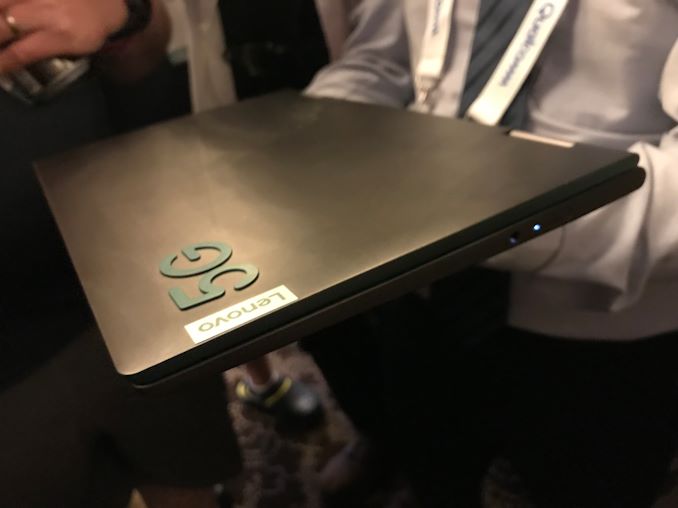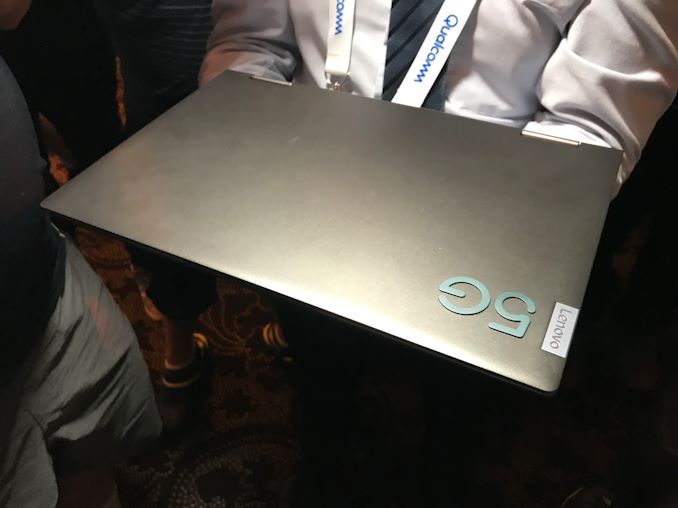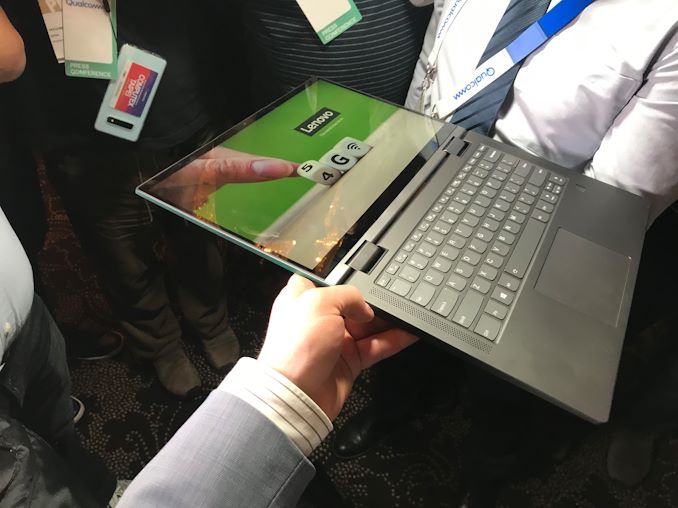Hands-On with Industry’s First 5G Laptop: A Lenovo with Qualcomm’s 8cx SoC and X55 Modem
by Ian Cutress & Anton Shilov on May 27, 2019 1:00 PM EST
Lenovo and Qualcomm introduced the world’s first laptop with an integrated 5G modem at Computex. The convertible notebook is based on Qualcomm’s latest platform for Windows 10 on Arm systems, the Snapdragon 8cx, and further includes the company's upcoming Snapdragon X55 5G modem. The PC is expected to be available later, but Lenovo is not disclosing its exact launch timeframe.
While Qualcomm and Lenovo have always promoted these devices as being super-efficient for ‘always connected’ workflows, leveraging the smartphone modem inside, these devices have actually seen more success when advertised for all-day battery life: by putting a smartphone chip in something the size of a laptop, the substantially larger battery makes the laptop last all day, and then some more. If there’s one thing that the Qualcomm always connected PCs (ACPCs) resonates with the tech press, it’s the phenomenal battery life. Now Qualcomm wants to pair that with a slightly more powerful chip, extending the capability in CPU and GPU.
Outfitted with what seems to be a 13-inch display featuring a Full-HD resolution (for now, Lenovo says it can install any screen, even an Ultra-HD one), the Lenovo 5G notebook (or 5GPC as the manufacturer calls it) is as thin and light as the company’s convertible Yoga C630 based on Qualcomm’s previous-gen Snapdragon 850. The Yoga design housing the new Snapdragon 8cx is the same chassis design as the previous generation (the Yoga C630). This is a super thin and light laptop that I really like. The downside of the older version was always the responsiveness, and the 8cx with its higher turbo performance promises to solve some of those issues. Similar to the previous ACPCs, a full version of Windows is being used, with Windows standard software and services being optimized for the Arm cores inside the Snapdragon SoC. The complaints about the previous models were mostly in ‘instantaneous performance’ – the performance that matters most when opening up programs and affecting the user experience. The new 8cx has a higher thermal envelope and can turbo higher – the chip has a can be set to a wide all-core TDP, over and above 10W, making a substantial difference.
Overall, the laptop feels to be a bit lighter than the majority of 13-inch notebooks on the market, possibly due to the lack of a sophisticated cooling system that normally accompanies x86 CPUs used in such PCs.
Meanwhile, the computer has a keyboard that feels rather nice: the keys are easy to press, yet they are located far enough from each other to minimize typos.
Qualcomm's new 8cx chip will feature a 4+4 Kryo 495 design, paired with 10MB of L3 cache and a large shared system cache. The GPU in this case is the Adreno 680, which is a much larger version of the Adreno 640 we see on the top end Snapdragon 855 which has powered most of the major 2019 smartphones. This chip is built on 7nm, and Qualcomm states is 60% more efficient than the Snapdragon 850 in the current generation of ACPCs.
As far as specifications are concerned, Lenovo says that it can equip its 5G notebook with up to 16 GB of RAM as well as a PCIe or UFS 3.0 SSD with up to 1 TB capacity. Since the product is set to be available later, Lenovo is being pretty flexible with its specifications, but it is likely that the company will offer multiple versions of its 5G-enabled notebook priced and speced differently.
When it comes to connectivity, the Lenovo 5G supports 802.11ac Wi-Fi (this is what the 8cx SoC supports), Bluetooth 5.x, and, naturally, 2G/3G/4G (Cat 22) and 5G via the X55 modem. It is noteworthy that the notebook exclusively uses Qualcomm’s X55 modem even for non-5G networks as the manufacturer believes that this is more power efficient. On the wired side of things, the Lenovo 5G notebook has two USB Type-C ports as well as a 3.5-mm headphone jack.
At present, Lenovo is not disclose anything about the actual launch date, price, or even launch countries. As far as availability goes, the linchpin would appear to be the X55 modem, as this is Qualcomm's next-generation 5G modem that's yet to ship (as the first X50-based devices only started shipping a couple of months back). As for pricing and availability, Lenovo still has some work to do to feel out the market for what kind a premium users are willing to pay for a 5G laptop, and then where 5G service is even readily available. This is one of the reasons why Lenovo does not want to disclose an exact launch timeframe, as the company wants 5G networks to roll out first and then release the laptop once demand is there.
| Want to keep up to date with all of our Computex 2019 Coverage? | ||||||
 Laptops Laptops |
 Hardware Hardware |
 Chips Chips |
||||
| Follow AnandTech's breaking news here! | ||||||















16 Comments
View All Comments
satai - Tuesday, May 28, 2019 - link
Can I get this with linux support?dm33 - Monday, June 10, 2019 - link
This! Linux support FTW. And I hope they release it before 5G is available. As others have said, I don't care about 5G but a faster ARM laptop would be awesome.Lordbravo - Wednesday, May 29, 2019 - link
This tablet has amazing specs besides this 5g thing. I just hope that the price won't be a cut throat onetkSteveFOX - Wednesday, May 29, 2019 - link
This is a good 5-6 months from being released to consumers, and yes, the 5G modem does support 4G Bands.I think Snapdragon 8cx machines will be very expensive from the start (looking at $1500+).
dm33 - Monday, June 10, 2019 - link
Why 5-6 months? I thought I had originally heard July.techies - Thursday, May 30, 2019 - link
5G means can insert SIM Card?